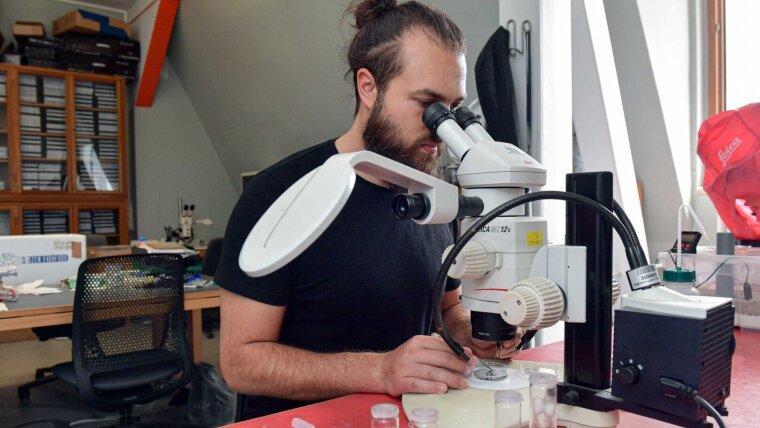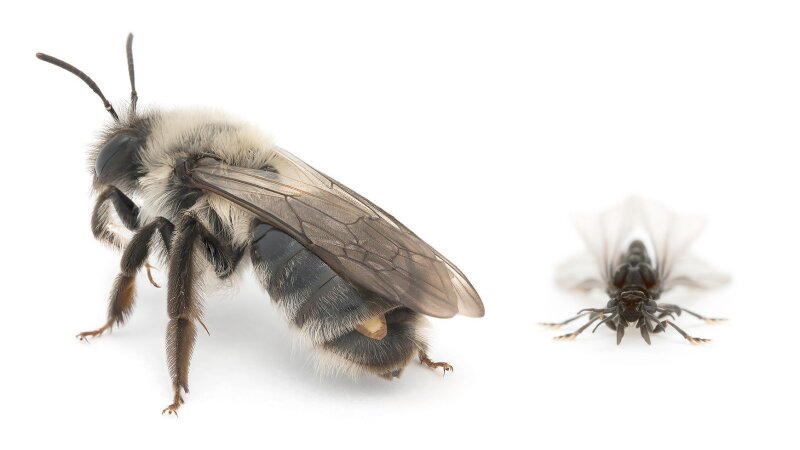
When insects of the order of twisted-wing parasites mate, their fate is sealed: While the males spend their extremely short lifespan with a single mating flight, the females pay for reproduction with their own lives. A research team has now figured out how they at least endure the traumatic mating.
By Ute Schönfelder
Reproduction in the insect order Strepsiptera - also known as twisted-wing parasites - is not for the fainthearted. To inseminate the eggs of its partner, the male partner injures the »neck« of the female with its hook-shaped penis and injects the seminal fluid directly into the body cavity. This traumatic insemination is risky for the female. For example, the injury may result in a loss of body fluid and invading germs may cause infections. However, in the course of evolution, the females of the strepsipteran species Stylops ovinae and Xenos vesparum have become morphologically well adapted to the brutal advances of their partners. This is the conclusion of a research team working at the universities of Jena, Kiel and Freiburg, and the Karlsruhe Institute of Technology, which reports on its findings in the scientific journal »PeerJ«.
A whole lifetime hidden in the abdomen of other insects
Twisted-wing parasites can be found all over the world. The fact that almost no one knows them is probably because, like many other insects, they are rather small and inconspicuous, measuring only a few millimetres. Apart from the extremely short life span of the males - only a few hours - the decisive factor is probably that »the females of the vast majority of the species spend their entire lives as parasites well hidden in the abdomens of other insects,« explains Dr Hans Pohl from the University of Jena.
Stylops ovinae, for example, lives in the mining bee (Andrena vaga) and Xenos vesparum in paper wasps (species of the genus Polistes). Only the cephalothorax, which is about as large as a pinhead, protrudes from the host. »So, in order to reproduce at all, the parasites have to come up with something,« says Pohl, an insect expert and head of the team of authors of the present publication. Because the male cannot reach the usual mating area on the female abdomen, only the anterior part of the female's body is available to inject the sperm.
However, as the team has now discovered, the females of the two species studied are not defenceless against the males during the traumatic penetration. »We were able to show that the cuticle of the females of Stylops ovinae and Xenos vesparum is clearly thickened in a certain part of the body between the head and the trunk. This is the region where the male stabs the female with his penis,« explains PhD student Kenny Jandausch, first author of the study.
The entire cuticle contains a lot of resilin, a protein molecule that makes the outer skin particularly elastic. However, as the skin at the puncture site is thicker than at other areas, the injury there is less dangerous for the female parasite because it allows the wound to close very efficiently. »In contrast to Xenos vesparum, this site forms a kind of pocket in Stylops ovinae into which the penis is inserted,« says Jandausch.
Broad range of methods reveals mating mechanism
But how exactly do the females attract the males? First of all, in a very classical way: »Virgin females emit an odour that attracts males from the surrounding area,« says Hans Pohl. The entomologists were able to observe this directly in the countryside around Jena. With a small cage of female twisted-wing parasites ready for mating, the researchers attracted males and took them back to their laboratory. There, they joined males and females in Petri dishes, observing them through a microscope.
They discovered that the females not only attracted males of their own species, but also other Stylops species tracked the odour, whereas only males of the same species were able to mate with the females. »Our hypothesis is that the mating pocket represents a prezygotic barrier that prevents mating between different species before fertilisation,« explains Hans Pohl.
In the end, however, there is bad news for female twisted-wing parasites: after the sperm has fertilised the thousands of eggs in her body, just as many tiny larvae develop, which are born alive a few weeks later - an event that the mother herself does not survive.
Left: Hidden in the abdomen of a mining bee lives a female of the species Stylops ovinae. Only the anterior abdomen pinhead-sized foregut (light yellow) protrudes from the host animal. Right: Frontal view of a male twisted-wing parasite.
Image: Hans PohlOriginal publication:
Have female twisted-wing parasites (Insecta: Strepsiptera) evolved tolerance traits as response to traumatic penetration? PeerJ 10:e13655, DOI: 10.7717/peerj.13655 External link
